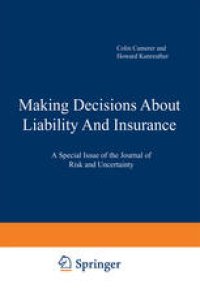
Ebook: Making Decisions About Liability And Insurance: A Special Issue of the Journal of Risk and Uncertainty
- Tags: Actuarial Sciences, Finance/Investment/Banking, Operation Research/Decision Theory, Microeconomics
- Year: 1993
- Publisher: Springer Netherlands
- Edition: 1
- Language: English
- pdf
Two related trends have created novel challenges for managing risk in the United States. The first trend is a series of dramatic changes in liability law as tort law has expanded to assign liability to defendants for reasons other than negligence. The unpredictability of future costs induced by changes in tort law may be partly responsible for the second major trend known as the `liability crisis' - the disappearance of liability protection in markets for particularly unpredictable risks.
This book examines decisions people make about insurance and liability. An understanding of such decision making may help explain why the insurance crisis resulted from the new interpretations of tort law and what to do about it. The articles cover three kinds of decisions: consumer decisions to purchase insurance; insurer decisions about coverage they offer; and the decisions of the public about the liability rules they prefer, which are reflected in legislation and regulation. For each of these three kinds of decisions, normative theories such as expected utility theory can be used as benchmarks against which actual decisions are judged.
Two related trends have created novel challenges for managing risk in the United States. The first trend is a series of dramatic changes in liability law as tort law has expanded to assign liability to defendants for reasons other than negligence. The unpredictability of future costs induced by changes in tort law may be partly responsible for the second major trend known as the `liability crisis' - the disappearance of liability protection in markets for particularly unpredictable risks.
This book examines decisions people make about insurance and liability. An understanding of such decision making may help explain why the insurance crisis resulted from the new interpretations of tort law and what to do about it. The articles cover three kinds of decisions: consumer decisions to purchase insurance; insurer decisions about coverage they offer; and the decisions of the public about the liability rules they prefer, which are reflected in legislation and regulation. For each of these three kinds of decisions, normative theories such as expected utility theory can be used as benchmarks against which actual decisions are judged.
Two related trends have created novel challenges for managing risk in the United States. The first trend is a series of dramatic changes in liability law as tort law has expanded to assign liability to defendants for reasons other than negligence. The unpredictability of future costs induced by changes in tort law may be partly responsible for the second major trend known as the `liability crisis' - the disappearance of liability protection in markets for particularly unpredictable risks.
This book examines decisions people make about insurance and liability. An understanding of such decision making may help explain why the insurance crisis resulted from the new interpretations of tort law and what to do about it. The articles cover three kinds of decisions: consumer decisions to purchase insurance; insurer decisions about coverage they offer; and the decisions of the public about the liability rules they prefer, which are reflected in legislation and regulation. For each of these three kinds of decisions, normative theories such as expected utility theory can be used as benchmarks against which actual decisions are judged.
Content:
Front Matter....Pages 1-4
Making Decisions About Liability and Insurance: Editors’ Comments....Pages 5-15
Intuitions about Penalties and Compensation in the Context of Tort Law....Pages 17-33
Framing, Probability Distortions, and Insurance Decisions....Pages 35-51
Transaction Analysis: A Framework and an Application to Insurance Decisions....Pages 53-69
Insurer Ambiguity and Market Failure....Pages 71-87
Ambiguity and Risk Taking in Organizations....Pages 89-94
Insurance for Low-Probability Hazards: A Bimodal Response to Unlikely Events....Pages 95-116
The Risky Business of Insurance Pricing....Pages 117-139
Two related trends have created novel challenges for managing risk in the United States. The first trend is a series of dramatic changes in liability law as tort law has expanded to assign liability to defendants for reasons other than negligence. The unpredictability of future costs induced by changes in tort law may be partly responsible for the second major trend known as the `liability crisis' - the disappearance of liability protection in markets for particularly unpredictable risks.
This book examines decisions people make about insurance and liability. An understanding of such decision making may help explain why the insurance crisis resulted from the new interpretations of tort law and what to do about it. The articles cover three kinds of decisions: consumer decisions to purchase insurance; insurer decisions about coverage they offer; and the decisions of the public about the liability rules they prefer, which are reflected in legislation and regulation. For each of these three kinds of decisions, normative theories such as expected utility theory can be used as benchmarks against which actual decisions are judged.
Content:
Front Matter....Pages 1-4
Making Decisions About Liability and Insurance: Editors’ Comments....Pages 5-15
Intuitions about Penalties and Compensation in the Context of Tort Law....Pages 17-33
Framing, Probability Distortions, and Insurance Decisions....Pages 35-51
Transaction Analysis: A Framework and an Application to Insurance Decisions....Pages 53-69
Insurer Ambiguity and Market Failure....Pages 71-87
Ambiguity and Risk Taking in Organizations....Pages 89-94
Insurance for Low-Probability Hazards: A Bimodal Response to Unlikely Events....Pages 95-116
The Risky Business of Insurance Pricing....Pages 117-139
....